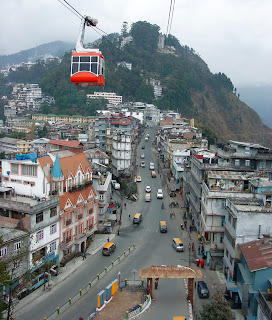You know how
people go to a new place, wear the place’s traditional attire and pose for
pictures that go up on walls and embellish homes. Here’s a little on the ones
that you may wear: the ones belonging to the three main communities of Sikkim. So
that when you smile from that silver frame, you can also talk about what you
are wearing in detail, to whoever is looking at it.
The lepcha man wears
the Thakro (a colourful sheet) Yenthatse (shirt) and a Shambo (cap). The Lepcha
female dress comprises of Dumbun (a kind of sheet worn sari style), Tago (loose
blouse), Nyamrek (belt) and Taro (cap). The beautiful ornaments used by the Lepcha
women are: Namchok (ear-ring), Lyak (necklace), Gyar (bracelet), etc.
The attire of a Bhutia male consists of Kho (Bakhu), Jya Jya (waist coat), Yenthatse (shirt), Kera (cloth belt) and Shambo (cap). The Bhutia female dresses are: Kho (Bakhu), Hanju (loose blouse), Kushen (jacket), Shambo (cap different in design than used by men), and Shabcha (shoe). Pangden, the striped apron is a symbol of married Bhutia women.
The
jewellery worn by the Bhutia women are known as Yencho (earring), Khao (necklace),
Phiru (pearl ornament), Diu (gold bangle) , and Joko (ring).
The common Nepalese men wear shirts known as Daura, while their Churidar
Pajama is known as Shurval, the waist coat is known as Aaaskot and their belt
is known as Patuki. The colourful sari worn by a Nepali woman is known as
Pharia, their long loose blouse tied from four sides is known as Chaubandi
Cholo, while another type of popular blouse is known as Tharo Cholo. A piece of
printed cloth covering the upper portion of the body is known as Hembari,
whereas a colourful piece hanging from the head to waist during a dance
performance is known as Pachauri.
The ornaments used by the Nepalese women are Sir-bandi (tiara), Kantha (necklace), Naugeri (necklace of pearl), Charanihari (another type of necklace), Tilhari (green bead with a long gold pendant worn normally by married women), Bulaki (nose-ring), Dungri (nose-pin), Tik-mala, Chandrahar, Chepti son (ear-ring), Gadwari (ear-ring), Chura of Silver (bracelet) and Kalli, thick heavy payal made of silver.
The ornaments used by the Nepalese women are Sir-bandi (tiara), Kantha (necklace), Naugeri (necklace of pearl), Charanihari (another type of necklace), Tilhari (green bead with a long gold pendant worn normally by married women), Bulaki (nose-ring), Dungri (nose-pin), Tik-mala, Chandrahar, Chepti son (ear-ring), Gadwari (ear-ring), Chura of Silver (bracelet) and Kalli, thick heavy payal made of silver.
So there goes. When you are here next month, make sure your take photographs of the pretty pretty flowers and while at them, a few of yourselves too.



















.jpg)